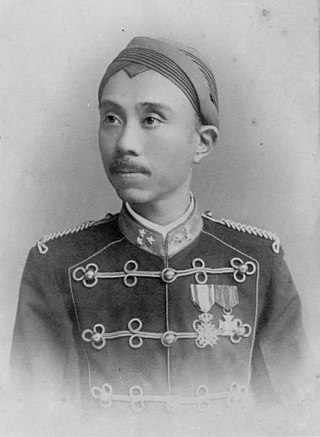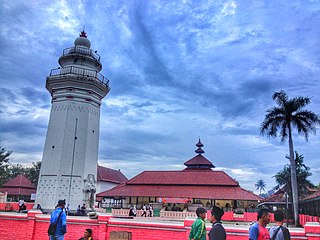
Satu Suro is the first day of the Javanese calendar year in the month of Suro, corresponding with the first Islamic month of Muharram. It is mainly celebrated in Java, Indonesia, and by Javanese people living elsewhere.

Surakarta Sunanate is a Javanese monarchy centred in the city of Surakarta, in the province of Central Java, Indonesia.

Mangkunegara VI was the prince of Mangkunegaran from 1896 to 1916.

Kauman Great Mosque, approximate English translation of Javanese Mesjid Gedhe Kauman, is a Great Mosque of the Yogyakarta Sultanate in Java, Indonesia. It is located to the west of the North Alun-alun of Yogyakarta Kraton.

The Great Mosque of Surakarta is an 18th-century Javanese mosque in Surakarta, Central Java, Indonesia. It is the royal mosque of the Surakarta Sunanate.

Sultan of Ternate Mosque, also known as the Old Mosque of Ternate, is an old mosque in Ternate City, Indonesia. It is the largest mosque in the city and the royal mosque of the Ternate Sultanate.

Kasunyatan Mosque is a small mosque in the village of Kasunyatan, Banten, Indonesia. Established between 1570 and 1596, it is one of the oldest mosques in Indonesia. The mosque is located in close proximity to the ruins of Old Banten, and functioned as a 16th-century centre of Islamic study. The mosque received a heritage status during the Dutch colonial period in 1932.

The Grand Mosque of Bandung, previously known as the Great Mosque of Bandung, is a mosque in Bandung, the a provincial capital of West Java, Indonesia. The mosque received the status of provincial mosque in West Java Province in 2004. It is located on the east side of the alun-alun of Bandung.

Great Mosque of Banten is a historic mosque in Old Banten, 10 km north of Serang, Indonesia. The 16th-century mosque was one of the few surviving remnants of what used to be the port city of Banten, the most prosperous trading center in the Indonesian archipelago after the fall of Demak Sultanate in mid-16th century.

Azizi Mosque is a mosque located in Tanjung Pura, Langkat Regency, North Sumatra, Indonesia. It was the royal mosque of the Sultanate of Langkat.

The Great Mosque of Malang is a mosque located in Malang, East Java, Indonesia. The mosque was built in 1890 and completed in 1903. The mosque is square-shaped, constructed with steel, and has a tajug on top. The original building is still maintained today.
Ranggawarsita Museum is a State Museum located in Semarang, Indonesia. As a State Museum, Ranggawarsita Museum is officially known as the State Museum of Central Java Province. The museum displays ethnographic collections of items related with the culture of the Province of Central Java

Kyai Gede Mosque, officially known as the Jami Mosque of Kotawaringin, is a mosque located in West Kotawaringin Regency, Central Kalimantan, Indonesia.

Mosque architecture in Indonesia refers to the architectural traditions of mosques built in the archipelago of Indonesia. Initial forms of the mosque, for example, were predominantly built in the vernacular Indonesian architectural style mixed with Hindu, Buddhist or Chinese architectural elements, and notably didn't equip orthodox form of Islamic architectural elements such as dome and minaret. Vernacular architectural style varies depending on the island and region.

Grand Mosque of Kubang Putih is an early 19th-century mosque located in the town of Kubang Putiah, West Sumatra, Indonesia. The mosque is designated as a cultural heritage object along with several other old mosques in West Sumatra, such as Bingkudu Mosque in Agam, Rao Rao Mosque in Tanah Datar, and the Ganting Grand Mosque in Padang.

Purwosari Station (PWS) is a large class type C railway station located in Purwosari, Laweyan, Surakarta, Central Java, Indonesia. The station which is located at an altitude of +98 m is included in the Operational Area VI Yogyakarta and only serves economy class trains across south and local or commuter.

The Sheikh Zayed Grand Mosque, Solo is a mosque in Solo, Indonesia, which is a smaller replica of the grand mosque in Abu Dhabi, the U.A.E. Built at a cost of US$ 20 million, it is named in honour of the UAE's founder, Sheikh Zayed bin Sultan Al Nahyan.

The Pura Mangkunegaran is a palace complex in the city of Surakarta, Central Java, Indonesia. It is the official palace and residence of the Duke of Mangkunegara and his family. The palace complex is one of the centers of Javanese culture and contains a museum exhibiting royal artifacts of Mangkunegaran.

Kedungjati Station (KEJ) is a class III railway station located in Kedungjati District, Grobogan Regency, Central Java, Indonesia. The station is located at an altitude of +36 meters and is operated by Operation Area IV Semarang. The station once had a junction to Ambarawa Station until it was closed in 1976.




















